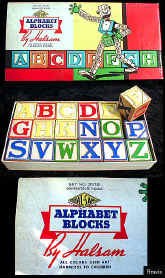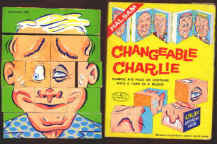|
 |
After WWI, Sam Jr. approached his father about entering the printing business.
Sam Sr. persuaded his son to find a market other than the printing business,
which was cyclical and unpredictable. Sam Jr. decided on manufacturing wood
toys, and together with Hal bought a woodworking company that was already making
wood blocks. |
|
A Halsam ad from
1927.
Click on image to enlarge. |
 |
 |
 |
|
A Halsam ad from 1932.
Click on image to enlarge. |
A Halsam ad from 1934
Click on image to enlarge.
|
A Halsam ad from "Billy
and Ruth" catalog ca 1930.
Click on image to enlarge. |
 |
They built a brand-new, 20,000 sq. ft. factory at 1417 Ravenswood in northern
Chicago. Goss and Elliott made special block embossing machines and domino
machines. The machines utilized the same technology as the rotary printing press
-- raw material (wood) put into one side of a machine and finished goods rolling
out the other. This early use automation allowed Halsam to quickly dominate the
block and domino markets, stealing substantial market share from their only real
competitor, the Embossing Company of Albany, New York -- the originator of
embossed ABC blocks.
into one side of a machine and finished goods rolling
out the other. This early use automation allowed Halsam to quickly dominate the
block and domino markets, stealing substantial market share from their only real
competitor, the Embossing Company of Albany, New York -- the originator of
embossed ABC blocks. |
| |
|
 |
Engineering and automation played a major role throughout the history of Halsam.
Machines developed for dominoes were used for a unique product called American
Bricks (later made out of plastic). (Applying the word "American"
boosted Halsam's sales and their "Frontier Logs" were very popular in
the South where the name "Lincoln Logs" hurt their competitor's
sales.)
|
| Halsam
produced point-of-sale displays for their American Logs sets such as
this sample. These were factory made - nailed together. |
| |
|
 |
Halsam was an innovator and industry leader in many other ways. Halsam was also
a founding member of the industry group, Toy Manufacturers of America. They were
one of the first toy companies to license Disney characters in the late 1920's.
Halsam marketed their ABC sets of "safety blocks" with
mechanically-rounded corners. They also developed "Hi-Lo blocks" with
interlocking grooved sides. Halsam was one of the first to use TV
advertisements. They also worked closely with large department stores and later
with pre-Toys-R-Us, deep-discount outlets such as Bargain Town USA.
|
 |
|
 |
Halsam was a pioneer into manufacturing plastic toys with their Elgo
(ELliot+GOss)
division. Beginning with bakelite dominoes and checkers, they improved their
products through the use of plastic-injection molding. A small Danish company
named Lego came to Chicago to meet with Halsam officials. Lego also made plastic
building bricks and was set to begin marketing in the United States. Because the
products and the company names (Elgo and Lego) were so similar, the Danish
officials wanted to avoid any unpleasantness. Sam's son, Bill Goss (the first to
speak with Lego officials), remembers the Lego executives as upstanding and
forthright. Lego paid Halsam a sum of approximately $25,000 to square itself and
clear the way for Lego's arrival in America. The rest, they say, is history.
|
|
|
|
 |
Halsam acquired toys from other companies, including the Changeable Charlie face
puzzle toy from Gaston Manufacturing Co. In 1955, they acquired toys such as
Color Cubes through the purchase of their largest rival, the Embossing Co. In
1962, Halsam was purchased by Playskool. In rapid succession, Playskool was
purchased by the Milton Bradley Co. of Springfield, MA, which was itself later
sold to Hasbro, Inc. of Rhode Island.
|